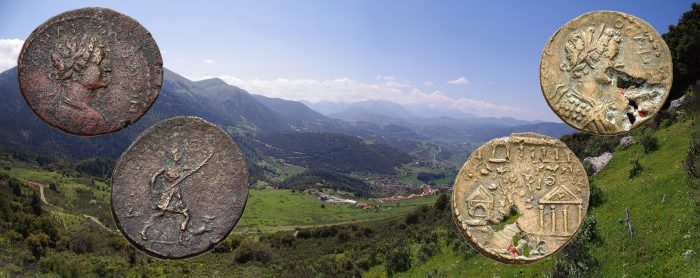Those who believe it is no longer possible to discover something as grand as a city previously undocumented on ancient coinage are one reason it is doable. Highlighted here are two recent examples of such “new” cities that issued bronze Roman provincial coins in the Peloponnese of southern Greece.
Taenarum (Tainaron)
Famous in antiquity for its cave that served as the mythical entrance to Hades and as a gathering place for Hellenistic mercenaries, Taenarum was thought to be “coinless.” That changed in June 2021, when an unidentified bronze of Julia Domna, the wife of Roman Emperor Septimius Severus (A.D. 193–211), was offered in Zeus Numismatics’s Web Auction 18. It sold for €600 (around US$716) to the Aiello Collection. The reverse shows the Greek legend TAINAPIΩN, “of the Taenarians,” around what is possibly a depiction of the statue of Poseidon seen by the ancient Greek traveler and geographer Pausanias (c. A.D. 2nd century).
Another coin, depicting Severus’s son Caracalla as co-emperor (197–211), appeared unattributed in March 2023 in Sol Numismatik’s Auction XI. A determined Dutch collector battled other bidders and paid €1,900 (around US$2,022) for it. The identity of the coin’s reverse figure is still a mystery.

Cynaetha (Kynaitha)
This story actually goes back to at least 1899, when the first reported Cynaetha coin was obtained by the Berlin Museum from the famous Egyptian antiquities collector and dealer Giovanni Dattari. Another Caracalla issue, the opposite side displays the marketplace of Cynaetha and the inscription KYNAIΘEWN. Disliked for their ruthless character, the Cynaethians lived on the rugged northern side of the Aroania mountain range.

Eventually, the Berlin coin was mostly forgotten. A new Cynaetha coin, this time of Severus, surfaced in a Syrian collection in June 2012 and was identified by a group of dedicated collectors, thanks to the “rediscovery” of the first coin. The new reverse displays an unknown goddess holding a scepter.
Currently, there are ten known coins of Cynaetha: five of Septimius Severus, four of Caracalla, and one of his brother, Geta. While a couple will likely never see the auction block, an example of Severus with an Asclepius reverse recently appeared in Roma Numismatics’s E-Sale 116, becoming the first Cynaetha coin fully identified in a modern auction. Keep searching!
A version of this article appears in the February 2024 issue of The Numismatist (money.org).
